1939
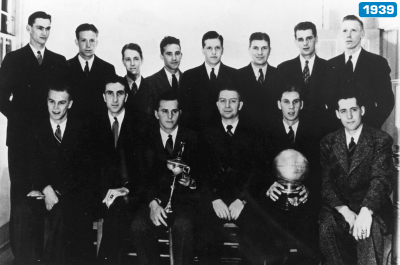 |
Oregon’s championship winning team from the first tournament in 1939.
Photo by: University of Oregon |
■ The first national collegiate men’s basketball tournament is held. For the first 12 years, district playoffs often were held with the winner entering an eight-team field for the championship. Oregon defeats Ohio State 46-33 to win the first championship, with the game played in Patten Gymnasium in Evanston, Ill.
1940
■ The National Association of Basketball Coaches holds its annual convention at the site of the national finals for the first time. It has been held there ever since.
1946
■ The championship game is televised locally for the first time in New York City by CBS-TV as Oklahoma State defeats North Carolina 43-40. The initial viewing audience is estimated to be 500,000.
■
This is the first time four teams advance to the final site. With only East and West regionals, the two regional champions play for the national title while the regional runner-ups play for third place.
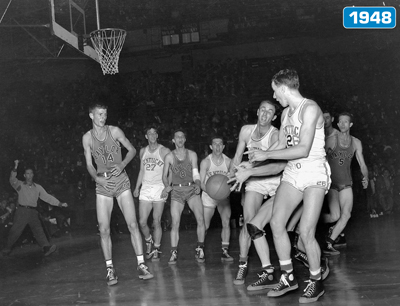 |
| Photo by: Getty Images |
1951
■ The field expands to 16 teams, with 10 conference champions qualifying automatically for the first time. Those 10 conferences: Big Seven, Big Ten, Border, Eastern (Ivy), Missouri Valley, Pacific Coast, Skyline, Southeastern, Southern and Southwest.
1952
■ Tournament games are televised regionally for the first time.
■ The number of regional sites changes from two to four, with the four winners advancing to the finals.
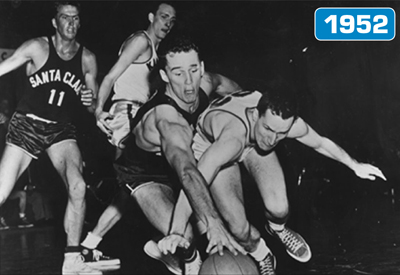 |
| Photo by: Getty Images |
1953
■ The bracket expands from 16 teams to 22 teams and fluctuates between 22 and 25 teams until 1974.
1954
■ The championship game is televised nationally for the first time as La Salle defeats Bradley, 94-76, in Kansas City.
1957
■ The largest media group to that point in the tournament’s history assembles for the finals in Kansas City. Coverage includes an 11-station television network, 64 newspaper writers and live radio broadcasts on 73 stations in 11 states.
1963
■ A contract to run through 1968 is signed with “Sports Network” for the championship game to be televised nationally. Television rights total $140,000.
1966
■ Net income for the entire tournament exceeds $500,000 for the first time.
■ A television-blackout provision requiring a 48-hour advance sellout is adopted.
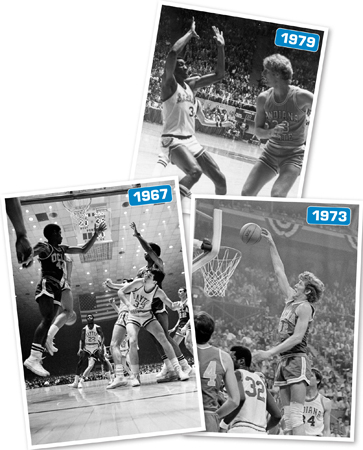 |
| Photo by: AP Images (1967, 1973); Getty Images (1979) |
1969
■ NBC is selected to televise the championship as television rights total $547,500, exceeding $500,000 for the first time. The tournament’s net income of $1,032,915 is the first time above the million-dollar mark.
1971
■ NBC records the largest audience ever for a basketball network telecast during the semifinals as 9.3 million households view the game.
1973
■ Television rights total $1,165,755, exceeding $1 million for the first time. The championship game on NBC receives a rating of 20.5 and is seen by 13.6 million television households reaching a total audience of 39 million people. For the first time, the championship game is televised in prime time.
■ TVS, with the approval of NBC, agrees to televise those games not carried by NBC for a two-year period at the rights fee of $65,000 per year.
1975
■ A 32-team bracket is adopted. For the first time, teams other than the conference champions could be chosen at-large.
■ The term “Final Four” first appears in an NCAA publication, the 1975 Official Collegiate Basketball Guide. In a section written by Ed Chay of the Cleveland Plain Dealer, Chay writes, “Outspoken Al McGuire of Marquette, whose team was one of the final four in Greensboro, was among several coaches who said it was good for college basketball that UCLA was finally beaten.”
1976
■ Host Communications of Lexington, Ky., wins the rights to the NCAA Radio Network.
1977
■ NBC televises 23 hours and 18 minutes of tournament programming.
1978
■ A seeding process is used for the first time for individual teams.
■ Complimentary tickets for all NCAA championships are eliminated.
1979
■ The bracket is expanded to 40 teams.
■ NBC receives a record one-game rating with a 24.1 in Michigan State’s national championship victory over Indiana State. The 38 share also sets a record.
1980
■ The bracket expands to 48 teams.
1981
■ Principles for the seeding and placement of teams is implemented to develop a balanced tournament bracket.
■ Virginia defeats LSU in the last third-place game conducted at the Final Four.
■ The NCAA registers a trademark for the term “Final Four.”
1982
■ The NCAA and CBS begin a three-year television agreement for the 1982-84 tournaments.
■ The “selection show” is shown on live national television for the first time.
1983
■ A new opening round requires the representatives of eight automatic qualifying conferences to compete for four positions in the 52-team tournament bracket.
■ North Carolina State’s national championship victory over Houston attracts a then-record 18.6 million households to the CBS telecast. The game has a 22.3 rating and a 32 share.
■ A national semifinal record also is set in Houston’s victory over Louisville. The game has a 17.8 rating and 33 share, and is viewed by 14.8 million households on CBS.
■ The NCAA requires that the Final Four competition venue must have a minimum of 17,000 seats.
1984
■ One additional opening round game is established, requiring 10 automatic qualifying conferences to compete for five positions in the 53-team bracket.
1985
■ The tournament bracket is expanded to include 64 teams, which eliminates all first-round byes.
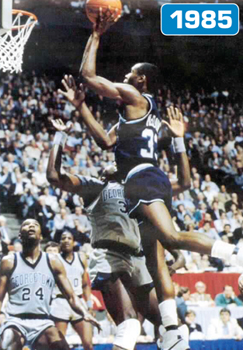 |
| Photo by: Getty Images |
■ CBS has a record 19.8 million homes view Villanova’s national championship victory over Georgetown. The game attracts a 23.2 rating and a 33 share.
■ The East Regional championship game (Georgetown defeats Georgia Tech) sets television records for that level of tournament competition with a 12.6 rating, a 32 share and 10.7 million homes tuned to CBS.
■ The NCAA Radio Network attracts 21 million listeners for the Villanova-Georgetown game.
■ CBS begins a second, three-year contract that includes the 1985-87 tournaments.
1986
■ CBS televises 40 hours, 51 minutes of tournament programming.
■ The NCAA Radio network includes a then-record 426 stations, including 92 of the top 100 markets.
■ For this year’s event in Dallas, the NCAA conducts its first random, computerized drawing for the general public’s allotment of Final Four tickets.
1988
■ CBS begins a third, three-year contract. All regional semifinal games are televised in prime time.
■ The NCAA celebrates the 50th anniversary of the Division I Men’s Basketball Championship. Coincidentally, the score in the Oklahoma-Kansas championship game is tied, 50-50, at halftime.
1989
■ After determining that three of the next four Final Four host facilities should have a minimum capacity of 30,000, the committee selects Charlotte, Seattle, The Meadowlands and Indianapolis to host in 1994, 1995, 1996 and 1997.
1990
■ The NCAA Executive Committee approves the “play-in” concept, which will be implemented the following year. Six conference representatives will play for three automatic-qualifying berths in the 64-team bracket.
1991
■ CBS Sports begins a new seven-year contract for $1 billion, which includes live coverage of all sessions of the championship through 1997.
1992
■ Duke University wins its second consecutive national championship, becoming the first team to successfully defend its title since UCLA in 1973.
1993
■ The minimum seating capacity for first and second rounds and regionals is established at 12,000.
■ The NCAA’s basketball committee selects San Antonio; St. Petersburg, Fla.; Indianapolis; Minneapolis; and Atlanta to host the Final Four in 1998, 1999, 2000, 2001 and 2002.
1994
■ President Bill Clinton becomes the first sitting president to attend the tournament, when he is present at the Midwest Regional championship game in Dallas and the national semifinals and final in Charlotte.
1995
■ The existing CBS Sports contract is replaced with a new agreement for $1.725 billion, extending for five years through the 2002 championship.
1996
■ The NCAA creates the first online computer page for the Final Four.
1997
■ The NCAA’s online computer page is expanded to include news from preliminary rounds.
1998
■ The NCAA’s basketball committee continues selecting Final Four host facilities with a minimum seating capacity of 30,000 when it picks New Orleans, San Antonio, St. Louis, Indianapolis and Atlanta to host in 2003, 2004, 2005, 2006 and 2007.
1999
■ The NCAA and CBS agree to a new 11-year agreement, commencing with the 2003 championship. The agreement, for a minimum of $6 billion, includes rights to television (over-the-air, cable, satellite, digital and home video), marketing, game programs, radio, Internet, fan festivals and licensing (excluding concessionaire agreements).
2000
■ Since 31 conferences will be eligible for automatic qualification in 2001, the NCAA agrees to conduct an opening-round game pitting teams seeded No. 64 and 65.
■ The NCAA and the Illinois High School Association form the “March Madness Athletic Association” and apply for trademark registration for the term “March Madness.”
2001
■ TNN telecasts the opening-round game.
■ The NCAA registers a trademark for the term “Big Dance.”
2002
■ ESPN televises the opening-round game for the first time.
2003
■ Westwood One assumes administration of the tournament’s radio rights.
■ The NCAA’s basketball committee sets the minimum Final Four seating capacity at 40,000 and picks San Antonio, Detroit, Indianapolis and Houston to host in 2008, 2009, 2010 and 2011.
2005
■ CBS begins a two-year deal with CSTV.com for exclusive Internet video streaming rights for out-of-market game coverage for the first 58 games of the championship. March Madness on Demand is born, originally as a subscription model and then moving to a free product beginning in 2006.
■ Attendance at first round, second round and regional sites is a record 98.4 percent of the facilities’ capacity.
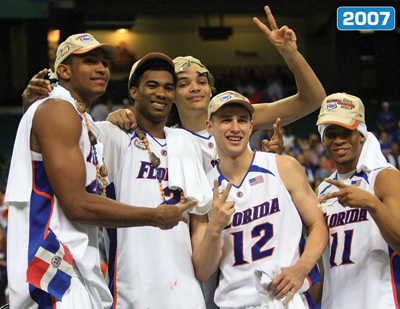 |
| Photo by: Getty Images |
2007
■ In response to traffic resulting in 19 million video streams and 5 million visits in 2006, CBS Sportsline doubles its bandwidth capacity for March Madness on Demand, which offers free live Internet streams of each game of the first three rounds of the championship.
■ The University of Florida becomes the seventh school to successfully defend its national championship as the Gators defeat Ohio State 84-75 in the title game.
2008
■ The continuing growth in popularity for ancillary events is on display as Hoop City attracts more than 63,000 visitors over a four-day period, while the Big Dance attracts 167,000 people to the streets of San Antonio.
■ For the first time, the NABC College All-Star Game is held at the same venue as the Final Four. The game attracts 4,800 fans to the Alamodome.
■ CBSSports.com and March Madness on Demand launch a developer platform that allows more than 200 websites to carry live video of the championship online, including sites such as ESPN.com, Yahoo, SI.com, YouTube and Facebook. CBS allows users to watch all 63 games that it telecasts during the tournament for the first time, and sees the total number of unique visitors from first-round games through the regional championship games grow from 1.75 million to 4.33 million.
2009
■ Record crowds attend the Final Four, with 72,456 fans attending the national semifinals and 72,922 fans in Ford Field
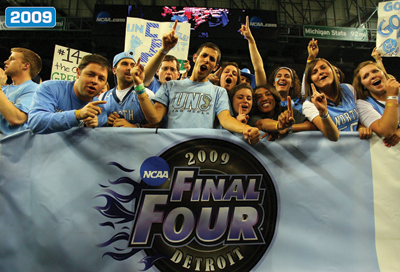 |
| Photo by: Getty Images |
for the national championship game. Records were also established at Hoop City, with more than 76,000 in attendance, and at the Big Dance, where more than 300,000 attended the three-day event.
■ The record crowd includes students from the four participating institutions sitting courtside after having the opportunity to buy specially priced floor-level seating. More than 400 students from each school were able to buy seats located behind the basket for less than $7 a game. The courtside student seating element was one of the benefits from the Final Four’s new center-court seating configuration, called “in the round.”
■ The Big East Conference becomes the first league to have three teams seeded No. 1 (Louisville, Pittsburgh and Connecticut) and the first to send five teams to the Sweet 16, with Villanova and Syracuse also advancing to the regional round.
2010
■ The NCAA exercises a clause in its contract with CBS, signed in 1999, to opt out of the deal in order to sign a new 14-year, $10.8 billion deal with CBS Sports and Turner Broadcasting. The television, Internet and wireless rights agreement also calls for CBS and Turner to collaborate on the NCAA’s corporate marketing program. All tournament games will be shown live across the country (on CBS, TBS, TNT and truTV), which is a first in the championship’s history. The agreement also involves expanding the tournament to 68 teams.
■ A revamped Bracket Town (formerly known as Hoop City) is a five-day fan fest that attracts nearly 53,000 people. The Bracket Town Competition Zones feature 12 basketball courts for exhibitions, training and fan games, including State Farm’s fan 3-Point and Skills Challenge Courts, the Coca-Cola fan Slam Dunk court, and the Powerade 3v3 Tournament. Bracket Town also debuts its new 2,500 seat Center Court Arena.
■ A total of 142,228 fans attend the two Final Four sessions. The attendance figures from the national semifinals, the national championship game and the combined attendance number are the second highest in Final Four history.
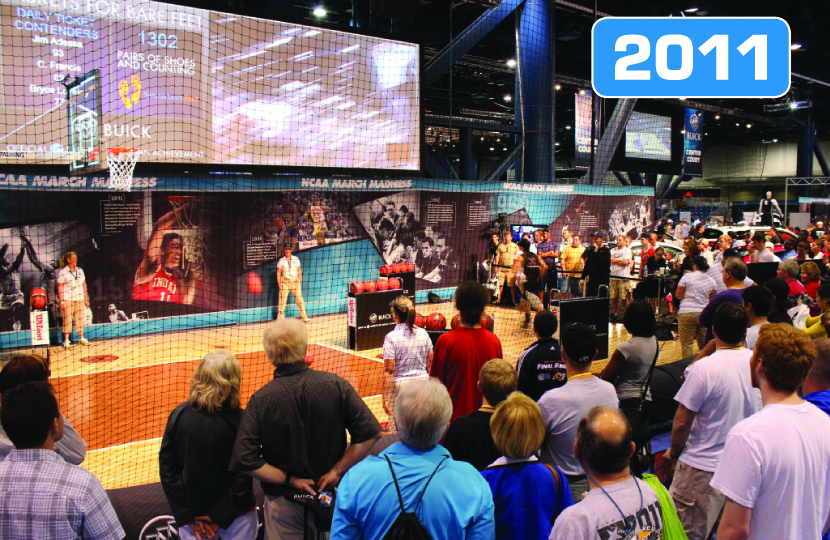 |
| Photo by: Intersport |
2011
■ The single-session attendance record is set on semifinal Saturday, as 75,421 fans pack Reliant Stadium. Another 70,376 fans attend the championship game, bringing the total Final Four attendance to 145,797.
■ For the first time, March Madness on Demand is available free to iPad and iPhone users in addition to online via NCAA.com. Despite the increased availability of games on TV, total visits to MMOD platforms, including broadband and mobile, rise 63 percent. In addition, over 13.7 million total hours of streaming video is consumed through the MMOD broadband application and iPad and iPhone apps.
2012
■ A total of 1,566 media members are credentialed for the Final Four, the most ever.
Source: NCAA, SportsBusiness Journal research











